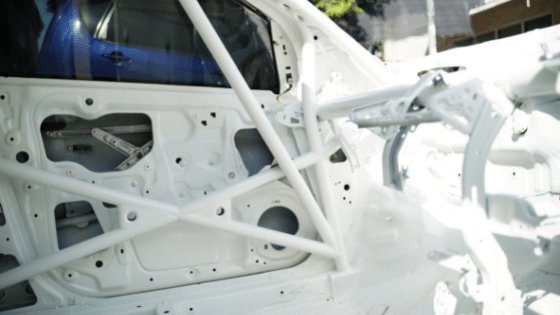
Dual-Phase Steel – or DP steel – is part of a category known as Advanced High-Strength Steels (AHSS). According to World Auto Steel, a division of the World Steel Association, AHSS are the result of carefully chosen chemical properties that are heated and cooled through precisely controlled processes. The result is material that is lightweight and affordable, yet able to meet strict safety, emissions, and performance standards. DP steel in particular is known for its ability to absorb high energy crashes. Read on to learn more about this useful component of modern auto manufacturing.

DP steel contains a mixture of ferrite and martensite. ‘Dual phase’ refers to the two phases in which the ferrite and martensite are processed to achieve certain characteristics. The ferrite phase, with its mostly pure iron content, contributes ductility, while the martensite phase creates a high tensile strength. Together, these elements provide a wide range of strength and ductility across DP steel types.
DP steels are alloyed by the following elements:
| Element | Range |
| Carbon (C) | 0.06%–0.20% |
| Manganese (Mn) | 1.5%-3.0% |
| Silicon (Si) | 0.15% |
| Chromium (Cr) | 0.5% or less |
| Molybdenum (Mo) | 0.2%-0.4% |
Other microalloying elements such as Nickel (Ni), Vanadium (V) or Niobium (Nb) can be used to create certain microstructures. Niobium, for example, has proven effective in increasing the processing window of low-carbon DP steels, thereby addressing issues of formability and weldability in certain situations.
DP steel is known for its combination of high strength and good formability. The n-value, a measure of high initial work hardening, is a good indicator of the level of formability of a metal. DP steel’s higher n-values indicate greater strain hardening capacity and the ability to distribute strain across a finished product.
Among high strength steels, DP steels feature a high tensile strength (TS). The most common TS levels for DP steels are 600, 800, and 1,000 MPa. After work hardening during forming, DP steels can also be bake hardened, which increases their yield strength (YS). For example, a sheet with a 350 MPa YS could increase its YS to more than 500 MPa with both work hardening and bake hardening.
In DP steels, carbon and other alloying elements are carefully balanced to produce unique mechanical properties, including resistance spot welding capability. Workability and weldability vary according to the balance of elements. When welding the higher strength grades (DP 700/1000 and above) to themselves, spot weldability may require adjustments to the welding practice.
Advanced strength steel like DP steel has surged in popularity in automotive manufacturing because of its ability to reduce vehicle weight and improve fuel economy.
Compared with conventional high strength low alloy steels, DP steels offer higher strength without reduced formability and can be used to meet the same design requirements as heavier metals.
DP steels are also known to be capable of absorbing large amounts of energy, which is highly beneficial in crash situations. These characteristics, combined with a low cost of production, make DP steels highly desirable for automotive applications.
DP steel has been recognized as very effective for outer body panel applications because of its formability and performance attributes.
Another advantage to the automotive industry is dent resistance. With dent resistance comes the opportunity for improved customer satisfaction, reduced warranty claims, and reduced in-plant damage. A high proportion of customer dissatisfaction with a car’s construction is attributed to dent and ding conditions. This dissatisfaction can lead to the eventual loss of future business. Therefore, the use of DP steel can prove strategically beneficial for automakers.
DP steels are well suited for automobile parts that are meant to absorb a lot of energy during an impact. DP steels are often used in the following automobile applications:
| Grade | Applications |
| DP 300/500 (C) | Roof outer, door outer, body side outer, package tray, floor panel |
| DP 350/600 | Floor panel, hood outer, body side outer, cowl, fender, floor reinforcements |
| DP 500/800 | Body side inner, quarter panel inner, rear rails, rear shock reinforcements |
| DP 600/980 | Safety cage components (B-pillar, floor panel tunnel, engine cradle, front sub-frame package tray, shotgun, seat) |
| DP 700/1000 | Roof rails |
| DP 800/1180 | B-pillar upper |
In conclusion, these steels offer excellent formability and high work hardening and bake hardening behaviors. These characteristics allow automotive designers to reduce the gauge and weight of outer panels substantially while maintaining or improving dent resistance. At the same time, they can possibly avoid substitution of costlier lower density materials and prevent intrusion into the passenger compartment during a collision. They allow the application of high yield strength steels to safety cage components that are too complex to form with other steels.

Steel base plates are fundamental elements employed in various manufacturing...
Metal fabrication is a critical process that transforms raw metal...
The solar industry has undergone a significant transformation by incorporating...

X
The Kloeckner Metals website uses modern technologies. Unfortunately, your browser doesn't support those technologies.
Download the latest version of one of these browsers to experience the site: